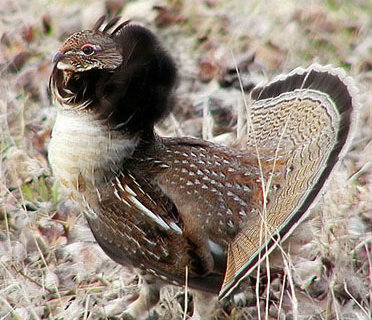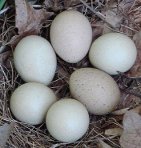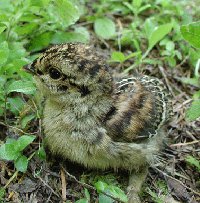Ruffed Grouse
Category: Game Birds

The Ruffed Grouse is the average-sized grouse that belongs to the genus Bonasa of the family Tetraoninae. The binomial name of this grouse is Bonasa Umbellus and it breeds in forests that range across the Canadian to Alaskan Appalachian Mountains. The Ruffed Grouse is a non-migratory grouse and it is the official state bird the State of Pennsylvania. Similar to nearly all grouse, the Ruffed Grouse spends most of its time on the ground, mixed forest, rich in aspen.
Features
The Ruffed Grouse is a chunky, average-sized bird that has a body length, ranging from 16 inches to 20 inches (40 cm to 50 cm), with a wingspan between 20 inches and 25 inches (50 cm and 64 cm) across its short, physically powerful wings. These birds have a body mass that ranges from 0.99 lbs and 1.65 lbs (450 grams to 750) grams.
The Ruffed Grouse is fairly a small grouse with a small, triangular top and an elongated, fan-shaped tail. The Ruffed Grouses have small legs and habitually appear slimmer than other grouse varieties. The Ruffed Grouses have two separate morphs, such as brown and gray. The brown-morph birds have the same color tails with the same pattern, but the remaining plumage is much tanner, offering the look of a more consistent bird with less pale plumage below and a noticeably gray tail.
On the other hand, the gray-morph birds have gray-brown colored neck, head, and back and their breasts are pale with barring. The underside and flanks of these birds are mostly white in color, and overall, these birds have a variegated look, with a distinctly lighter throat. The tail of these birds is fundamentally the similar brownish gray, with a standard barring and a wide black band close to the end.
The ruffs are available on the sides of the neck in both male and female birds. The Ruffed Grouses have a crest over their head, as well, which occasionally lies flat. Both male and female birds are similarly sized and marked, making them hard to identify, even in hand. Habitually, the female Ruffed Grouse features an interrupted sub-terminal tail band, whereas male birds are inclined to have uninterrupted tail bands, though the opposite of both can take place. Female birds may, as well, perform a display analogous to the male. Another reasonably accurate indication is that rump feathers with one white color dot designate a female, whereas rump feathers in excess of one white color dot designate a male grouse.
Diet
The Ruffed Grouse mostly feeds completely on plants, including buds, leaves, and fruits of shrubs, ferns and woody plants. During the fall, it feeds on acorns and soft fruits.
Behavior
The Ruffed Grouse can be seen mostly foraging on the floor of the forest interior for insects and seeds. Displaying male birds make a profound, airy drumming noise by hitting their wings when standing on a log. During the spring season, they leave their groups and they will be alone. During the summer season male birds can be seen with female birds with broods of baby birds. Winter birds create groups and they often feed on the sprouts of deciduous trees.
The average lifespan of the Ruffed Grouse is one year, but if the bird survives its first year, it can live up to 3 years.
Generally solitary birds, ruffed grouse do not develop pair bonds, and one male may breed with several hens. Following mating, hens construct nests and lay 8 to 14 cream-colored eggs.

If the nest is destroyed, hens will often attempt to renest.
Nests are shallow depressions in the leaf litter, often at the base of a tree, stump or bush, and normally located in second growth hardwoods. Eggs are incubated by the hens and hatch in 24-26 days.

Chicks are precocial (highly independent from birth), and leave the nest soon after they hatch to follow the hen and start feeding. Hens stay with their broods until they are grown. During autumn, juvenile birds can disperse from natal habitats up to two miles or more.

 Back To Category Game Birds
Back To Category Game Birds